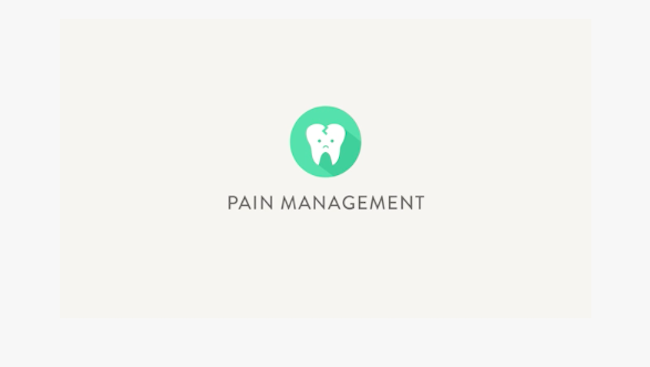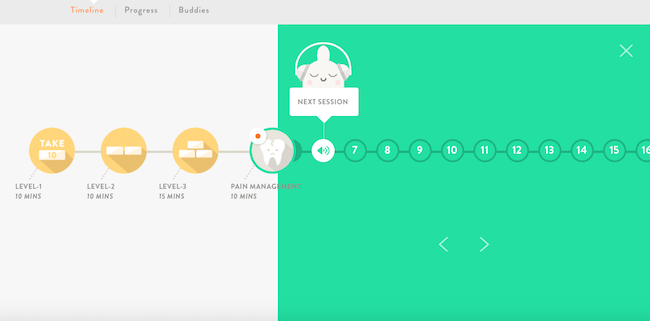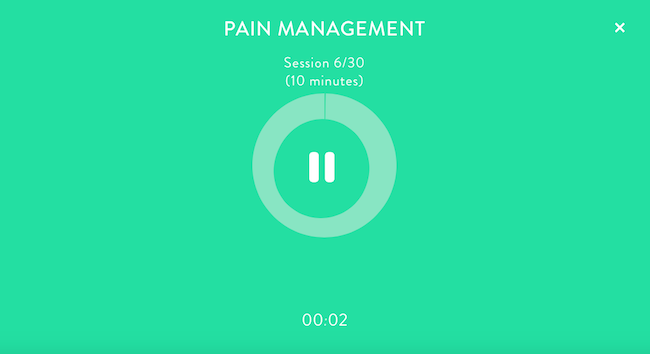Pain sucks.
Hard.
It’s funny, considering I’ve been in pain for so long, you’d think that I’d be used to it by now. Alas, it doesn’t work like that (bloody body fire alarm), and my pain remains the gift that keeps on giving (and never-ever seems to disappear!)
I deal with two types of pain: the chronic pain that is always there, and is pretty much my ‘normal’. It’s the dull (if dull can also be considered stupidly strong) ache that is in my joins, muscles and bones. And then there’s the acute. That’s the extra intense pains that appear whenever I move in the wrong way, or my joints decide to go on a bit of a holiday. That stuff is like an added layer of ‘ouch’, that pops up (or out) without warning, constantly takes me by surprise. I feel like I’m permanently engaged in battle with my body for supremacy – fighting through the pain and fatigue to try and live my life as well as possible.
An EDS body is like being in the body of someone who was just in an accident. Every. Single. Day. It took me a really long time to find pain relief that even took the edge off a little, waiting over 7 years since getting a formal diagnosis to even be given the ‘good stuff’. I now wear a morphine patch and take liquid morphine for breakthrough pain (I find this particularly helpful when I have to go out and get through events). In spite of this, pain is nearly always on my mind; a distraction from life that I can’t seem to escape. I can’t even imagine how I’d feel if I wasn’t taking the medication that I do.
I’ve tried so many things over the years to try and get my pain under control: massage, osteopathy, pilates, acupuncture, diet, other medications, you name it, I threw money at it, in a desperate attempt to find some relief.
I tried mindfulness meditation before with Headspace, and it’s something that I had mixed experiences with. I find it really, really hard to get into meditation, as I’m not good with just ‘sitting’. I don’t really have a brain that’s good for that, and I find it hard to commit to it. I know, it’s a ‘practice’, and a skill that takes time and dedication. But it’s one of those things that always took me a long time to get into, and then when I did I was fine, and as soon as I’d miss a day, it’d be pretty certain that I’d stop.
Over time (and I’m talking a period of months here), I did improve, and start seeing some benefits in actually being able to take a little bit of time out from pushing myself to work and generally feeling crap. I found it relatively relaxing, although I don’t have any data on whether it helped with my anxiety levels or not, my mother reported that at the time I did find it beneficial.
That being said, one thing that always frustrated me about mindfulness meditation (I don’t do ‘spiritual’ meditation, as it’s totally not my jam) is that there’s always a focus on the body, and how it feels. I never liked being told to sit there and scan my body, thinking about those sensations.
I’m doing this to forget about my body, you guys. Don’t ask me to think about it. Jeeze!
With all the other expensive treatments that I have to pay for on a monthly basis, I couldn’t justify the membership fee, when it was something I was just dipping into, and stopped a couple of years ago.
I was recently approached by the lovely Sara at Headspace, who asked me if I would be interested in trying a new pack that they’ve been working on, specifically for people with chronic pain. With my workload and stress levels increasing, and my health suffering as a result, I jumped at the chance to give it a go and see if it could make a difference to my life. I’ve been looking for something specifically tailored for people with pain for a while, so it was really exciting to get early access!
As always, the pack started with a video from Headspace founder, Andy, explaining what the next 30 days would entail. As I expected, it’s not something that is a miraculous cure to pain (always run away from anyone claiming they have one as fast as your little legs can take you). Instead, it aims to help us take some time to learn more about our own unique experience of pain, and help us challenge the ways we perceive it. Importantly, he mentioned the importance of approaching this series with an open mind, free from expectation.
Yes, sir!
If I’m honest, I really struggled to get into pack, but that has nothing to do with Headspace itself. On my first day, my pain levels were through the roof, I only slept an hour, my heart palpitations were a-palpitatin’ and I was extremely stressed out from ridiculous freelance issues that made me incredibly upset and frustrated. Frustrated doesn’t work well for me. My body can’t seem to clear those hormones, and the physical responses just last and last, completely throwing my body off its already slightly-off kilter!
When my stress levels, pain, and fatigue are high, I find it almost impossible to just sit and be with myself, even if I have an app for company. I couldn’t seem to bring myself to work through the pack every day, as I had initially planned. When I have a lot to do, I find myself running off of adrenaline, and just keep going. And when I try to force myself to rest, I’m just binging my way through the Gilmore Girls at an exceptionally impressive speed.
I found that I was repeating some of the sessions, because I felt like I wasn’t in the right ‘headspace’ on the days that I initially did them in order to get the most benefit. Things have calmed down a little bit over the last few days, and I’m going to Paris tomorrow, so I’m planning on re-starting everything and promising myself that I will do this every day for the next 30 days, and take a long hard look at my daily schedule, and figure out if I can make it a bit kinder to myself.
When it comes to concepts around pain, and my own personal experiences with them, I also like to take more time to ruminate on how I feel (and sometimes write a diary) to help me figure out how I feel about it all. I don’t believe that just because something is 30 days, we need to be forced to do it every day (or not to repeat days). This is especially the case when mindfulness is generally something you really struggle with. I’d rather take the time to nail the concepts, than to just rush through for the sake of it.
Sitting down with this pack on Day 1 felt like many other Headspace sessions that I had done, with Andy walking us through the basic concepts of mindfulness before leading a ten minute meditation.
I’m glad that the beginning of the pack goes over mindfulness fundamentals, as I find them really hard to get to grips with. One of the reasons I loved Headspace is that there’s an acceptance that our minds were going to wander. Those thoughts are encouraged, and set free, made part of the meditation in a way that didn’t make you feel like you were failing because you can’t just sit and focus on your breath for ten minutes at a time.
I was initially a bit disappointed that he asked us to do the full body scan within the first few minutes, but then he asked us to literally focus on the pain (like I can pick one place!) and I have to admit, I was intrigued. My brain didn’t know where to go and I felt like I was in a funny dance, running my mind across my body, realising that there is no longer a place where I don’t experience pain (woo). But I was thinking about the pain in a high level way, instead of sitting and experiencing it.
The first key concept we explore in the pack is resistance. Andy explained that when we experience pain, it’s totally natural to want to fight it. He argues that the process of resisting pain can actually intensify it: by mentally applying resistance to try and fight our pain, we increase tension in the body, which can then make our experience of pain worse.
I know that whenever I allow myself to think about how I feel, everything becomes so much worse. Which, I suppose is why I generally am pushing through so much, constantly ‘doing’ something, so I never have to be alone with my pain. Fully ‘taking time off’ is never an option for me, as I totally crash for weeks on end – so finding a lower level that I can keep up consistently is incredibly important.
The aim of this part of the pack is to find ways to step away from that resistance. The idea is that, no matter what we do, pain is is going to be there anyway (sad, but true), so instead of fighting it, we try and step out of the way. It’s not that the pain will just disappear or pass by, but if we can learn some skills to help us step out of our usual cycles and current ways of experiencing pain, we can witness the sensations without *feeling* them as strongly. Essentially, it’s like being aware something is there, without totally falling deep into it. I should also try and apply that to my phobia of pigeons – it would be nice to just recognise that they’re there (and disgusting) and not literally walk into the road, screaming, to try and avoid them.
By sitting and scanning my body for pain, but not actually focussing on it, I could accept and note that the pain was there, and then start to train my brain to move on and think about something else. I think, if practiced in the long-term (and aside from external distraction of work or Netflix), it could be a very helpful skill to have.
Overall, I’m really excited that Headspace have created a pack to help people suffering from pain. Unfortunately, there’s so little long-term care available to help those of us find ways to cope on a day-to-day basis, that other interventions are very much needed. More often than not, we’re just left to get on with it, with little thought or care for the mental health impacts that severe chronic pain can lead to.
I know that a lot of people are sceptical about stuff like this. Pain management and CBT did not work for me at all, and I’m as anti-woo as you can get. That being said, I do think that even if you if you struggle with mindfulness and meditation, just the process of taking time to sit and think about the way pain affects our lives, and how we’re personally affected by, and respond it, iss a really helpful exercise. And if we can learn some skills to help us change our experience of pain, even better.
It’s also just nice to feel like we’re able to do something ‘active’. So often, when it comes to pain management, we’re reliant on people doing something to us: be that giving us medication, or physical manipulation work. I always find I feel so much better about myself when I’m actively engaging in the management of my health.
The first few days brought up a lot of interesting points about the way we individually experience pain, and how pain is experienced as a society. Andy talked about how if we stop thinking about pain as inherently good or bad, we can free up the mind and body to experience our pain in a different way, and I’m intrigued to hear more, and see if this is truly the case for me.
I’m looking forward to seeing if this pack can help give me some more Headspace, because I bloody well need it!
UPDATE: You can find out how I got along during my trial here.
This post was sponsored by Headspace in return for an honest review. Check them out here!




I was very lucky to get a pain management mindfulness course free on the NHS about 5years ago as part of their pain clinic (I have fibromyalgia) it was a 12 week course every afternoon on a Wednesday for 12 weeks. Genuinely the first week I thought it was insanity personified but I stuck with it and five years later I still practice because learning how to sit with the extreme pain I was in and not judge or fight it was pivotal in accepting my condition and pain and it makes a big difference it won’t cure me it can’t fix the pain but it really helped me to stope hating it so much which freed back up some of the small amount of energy I have in a day xxxx
Natasha, it is an excellent idea the New Headspace Pain Management pack because I understand that it is uncomfortable to be in pain all the time. I would hate it too if I was in so much pain like you. I would be cranky all the time.
It’s very easy to be cranky!
I look forward to hearing more about your progress! Personally, I am struggling with meditation myself. It is intriguing, though, that this approach seems to lead to more of accepting the pain instead of trying to make it go away.
Speaking of going away, I am curious to see if by accepting the pain it will eventally make the pain go completely away. I know that you said that this isn’t the goal of this meditation, but I’m wondering if it my be a side affect of letting go of trying to make the pain go away, oxymoron as it is.
I also wonder if there will be other interesting and unexpected side affects, like better sleep (which I struggle with), less fatigue, and other things.
I look forward to hearing more!
Thanks Crystal! Sorry for the delay in getting back to you – I’ve been taking a blog break! There’s an update post on my Instagram where I wrote about my full experience if you’d like to read it. 🙂
Thx so much for sharing your experience! I am a huge headspace fan and super glad to read about their pain pack now! Sounds def like sth I should try!
Thank you, Carina! I did an update on my Instagram after trying the whole thing. I realised that it’s not quite for me, but the pack itself is great, and I’m sure will help a lot of people!